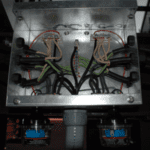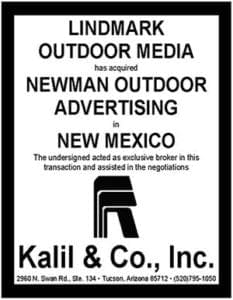This is the last in a series of articles by Kevin Conlin on solar powered billboards. It sums up what’s necessary to make a solar powered billboard a success. Kevin Conlin is a 30 year veteran of the solar industry. His company, Autonomous Power Solutions, has developed the Work Horse line of solar lighting systems for the outdoor advertising industry. Kevin Conlin, Autonomous Power Solutions
 Solar billboard lighting has been around for 30 years, but it’s only recently, with the development of high efficiency LED lamps, have solar billboards matched the light levels of line powered boards. Unfortunately, that doesn’t mean you will need a reliable solar system and compatible lights that will last the life of the board. A poorly designed or sized solar system can impose an untenable burden in terms of frequent service calls, high maintenance expenses and excessive replacement costs. On the other hand, a well-designed solar system will provide many years of trouble free service. Here are 11 tips I’ve learned over the last 30 years of building high reliability, remote solar power systems
Solar billboard lighting has been around for 30 years, but it’s only recently, with the development of high efficiency LED lamps, have solar billboards matched the light levels of line powered boards. Unfortunately, that doesn’t mean you will need a reliable solar system and compatible lights that will last the life of the board. A poorly designed or sized solar system can impose an untenable burden in terms of frequent service calls, high maintenance expenses and excessive replacement costs. On the other hand, a well-designed solar system will provide many years of trouble free service. Here are 11 tips I’ve learned over the last 30 years of building high reliability, remote solar power systems
It’s all about the lights.
 Skimp here and you’re wasting your time. Use only high quality, brand names you can trust. They may pull more power, but that’s because they’re brighter and have better optics than the inexpensive brands.They may cost more, but it’s because they’re built to last. LED’s are touted as lasting 100,000 hours. But that’s only true if the light around it and the driver powering it are also built to last 100,000 hours. (at 6 hours per night, that’s 45 years)
Skimp here and you’re wasting your time. Use only high quality, brand names you can trust. They may pull more power, but that’s because they’re brighter and have better optics than the inexpensive brands.They may cost more, but it’s because they’re built to last. LED’s are touted as lasting 100,000 hours. But that’s only true if the light around it and the driver powering it are also built to last 100,000 hours. (at 6 hours per night, that’s 45 years)
 Use Realistic Winter Weather Data
Use Realistic Winter Weather Data
If you use average sun sunlight, (peak sun hours) instead of winter sun hours, your system will fail frequently during an average winter, and repeatedly during a bad winter. Your revenue depends on reliability, and reliability starts with a properly sized solar system. Frequent failures also dramatically reduce the life of the batteries, requiring frequent, and expensive, replacement.
 Don’t skimp on batteries
Don’t skimp on batteries
Only the southwest desert areas of the US can get by with 5 days of re- serve, everywhere else should have at least a week, preferably 9 – 10 days. Yes, they cost more, but they double the reliability of the system and the life of the batteries. Batteries should last a minimum of 5 years, and a properly sized wet battery bank should last 10 years, even in hot climates.
 And protect them
And protect them
Protect your batteries from the elements, both natural and human. Sun shades protect not only from sunlight, but wind, snow, driving rain and other weather extremes, as well as from prying eyes. Avoid plastic battery boxes or control enclosures, they are prone to cracking and degradation in sunlight, and generally overheat the batteries, shortening their life considerably. They are also harder to secure, and are prone to cracking from the stress of larger conduit.
 Use a lightning container box.
Use a lightning container box.
Use a lighting combiner box to avoid wiring errors and facilitate troubleshooting. DC lights can’t be wired like high voltage AC lights, and a junction or combiner box is simple to understand and provides a central access. Protect your lights and electronics with a pair of high quality surge arrestors, one for each side of the board, in the junction box. 24VDC lights are wired differently than AC lights, and most electricians are not familiar with DC wiring practices. The lighting combiner box assures a quick, correct installation. Large surge protectors, one for each side of the sign, are mounted below.
 Use heavy guage wires
Use heavy guage wires
Use heavy gauge wires and larger conduit than you’re used to using. Most DC lights are 24VDC, and given the longest wire run from the ground to the farthest lights, AWG#6 is required up the pole, and AWG#10 to each light from a central combiner box. This prevents excess voltage drop, meaning brighter lights. AWG#6 wire is used from the controls to the light combiner box, AWG#10 is then run to the lights to prevent excessive voltage drop.
 Choose your timer carefully.
Choose your timer carefully.
Choose your timer or controller carefully Without the 60HZ that usually keeps a timer accurate, DC systems typically require a DC/DC converter to provide clean, regulated power to the timer or remote control that controls the lighting schedule. Again, it’s a good idea to protect the timer and solar controls with another high quality surge arrestor in the control enclosure. A Solar MPPT controller is shown, upper left, individual load controllers for each face are shown center, DC/DC converter upper right provides clean power to the TORK timer. A TORK astronomical timer, grey box on the right, is used to control the lights each side of the board separately
 Don’t use outdated technology.
Don’t use outdated technology.
The best systems use standard, large area solar modules combined with Maximum Power Point Tracking (MPPT) battery charging, for highest solar system efficiency, and long term assurance replacement solar modules will be available. These solar modules all have very similar dimensions and electrical characteristics, regardless of manufacturer, and an MPPT charger is 10-15% more efficient than the older PWM chargers. A Solar MPPT controller is shown, upper left, individual load controllers for each face are shown center, DC/DC converter upper right provides clean power to the TORK timer.

Design for long life.
Durable materials such as hot dipped galvanized steel, powder coated aluminum battery and control enclosures, stainless steel fasteners and bronze grounding lugs. A well designed solar power system should last a minimum of 30 years with little degradation. The solar system should be designed to outlast the sign it’s powering.
 Protect your assets
Protect your assets
Tamperproof fasteners to create multiple barriers to entry. Padlocks are now vulnerable to cordless grinders and can be cut in seconds. Use round, solid padlocks encircled in steel, and tamperproof fasteners with security rings to deter theft. SmartLink systems can also be equipped with security features for monitoring and protecting remote systems.
Consider weather
Consider weather extremes, especially the wind loading on solar modules during a hurricane. Most of the sunnier parts of the US are also subject to occasional high winds and gusts, and will see them many times over the 30 year life of the system. Coastal solar systems should be designs to withstand 120 mph winds. Inland solar systems should be designs to handle 100 mph winds.
[wpforms id=”9787″ title=”true” description=”true”]


















Great information on all points. Having a reputable manufacture is key to getting a system developed that can meet the needs of the billboard project for years versus looking for the lowest cost system that may fall apart after a couple years of operation.